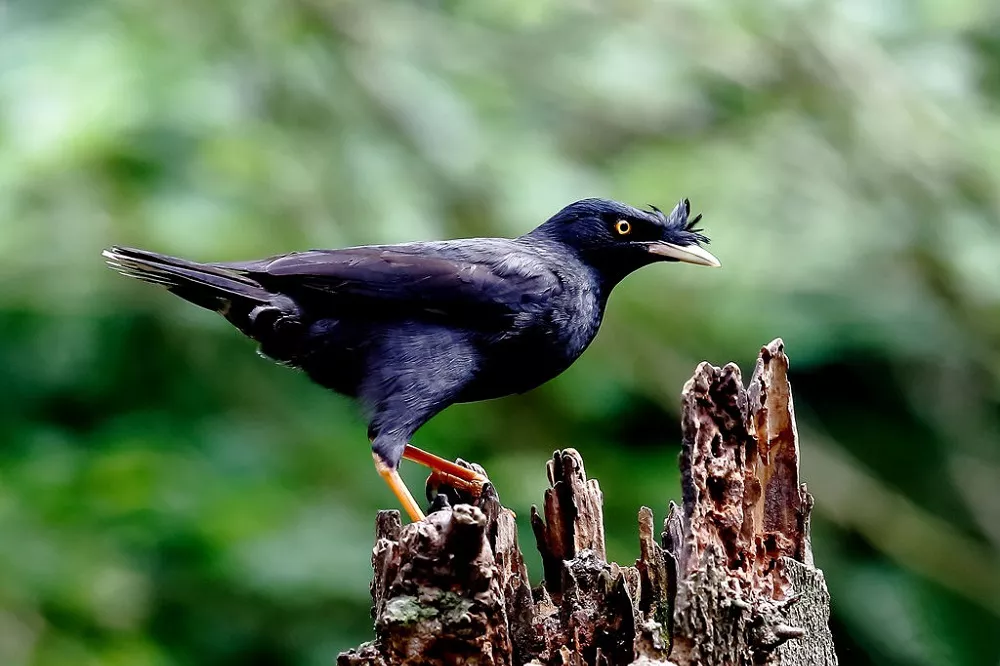Within the vast and diverse world of avian species, the crested myna (Acridotheres cristatellus) stands out as a remarkable and captivating bird. Known for its distinctive physical features and intriguing behavior, the crested myna has captured the interest of ornithologists and bird enthusiasts alike. In this article, we will delve into the fascinating world of the crested myna, exploring its characteristics, habitat, behavior, and conservation status.
Physical Characteristics:
The crested myna is a medium-sized bird with a length of approximately 26-30 cm and a wingspan of 37-42 cm. Its most notable feature is a prominent, elongated crest atop its head. The crest is composed of black feathers that can be raised or lowered, depending on the bird’s mood and level of excitement. Additionally, its plumage exhibits a striking combination of glossy black feathers on the body, contrasting with bright yellow patches on the wings and a yellow bill. These unique physical attributes make the crested myna easily identifiable.
Habitat and Distribution:
Native to China, specifically the southern regions such as Guangdong, Guangxi, and Hong Kong, the crested myna thrives in subtropical and tropical environments. Within these habitats, they can be found in various types of landscapes, including forests, grasslands, urban areas, and agricultural fields. However, due to human activity and habitat loss, their range has become more fragmented in recent years.
Behavior and Communication:
Crested mynas are highly social birds, often forming small to large flocks comprising several individuals. Their communication is complex and diverse, involving a wide range of calls, songs, and displays. They are known for their ability to mimic other bird species and even human sounds, showcasing an impressive vocal repertoire. These mimicking abilities are thought to serve social and territorial purposes within the flock.
Feeding Habits:
The crested myna has an omnivorous diet, consuming a variety of foods. Their diet primarily consists of fruits, insects, small vertebrates, and nectar from flowers. In urban environments, they are also known to scavenge for food around human settlements. This adaptability in feeding habits contributes to their success in diverse habitats.
Breeding:
Breeding in crested mynas occurs during the spring and summer months. Males will compete for females by displaying their crest feathers and singing loudly. Once a male has successfully attracted a mate, they will build their nest together. The female will lay 3-6 eggs, which both parents will incubate for around two weeks. After hatching, both parents will take turns caring for the chicks, feeding them insects and regurgitated food until they are ready to fledge.
Conservation Status and Threats:
The crested myna is classified as a species of Least Concern by the International Union for Conservation of Nature (IUCN). However, like many other bird species, they face threats due to habitat destruction, pollution, and the illegal pet trade. The destruction of their natural habitats and the conversion of land for agricultural purposes have resulted in population declines in some regions. Conservation efforts are crucial to protect and preserve their habitats, raise awareness about their ecological importance, and discourage illegal trade.
Conclusion:
The crested myna is a captivating bird species, exhibiting unique physical characteristics, complex communication patterns, and versatile feeding habits. As with many other avian species, its survival is threatened by human activities and habitat loss. Conservation efforts, such as habitat protection and public awareness campaigns, are essential to ensure the continued existence of this remarkable bird. By understanding and appreciating the crested myna, we can contribute to its conservation and foster a greater appreciation for the biodiversity of our planet.


 Facebook
Facebook  Instagram
Instagram  Youtube
Youtube 